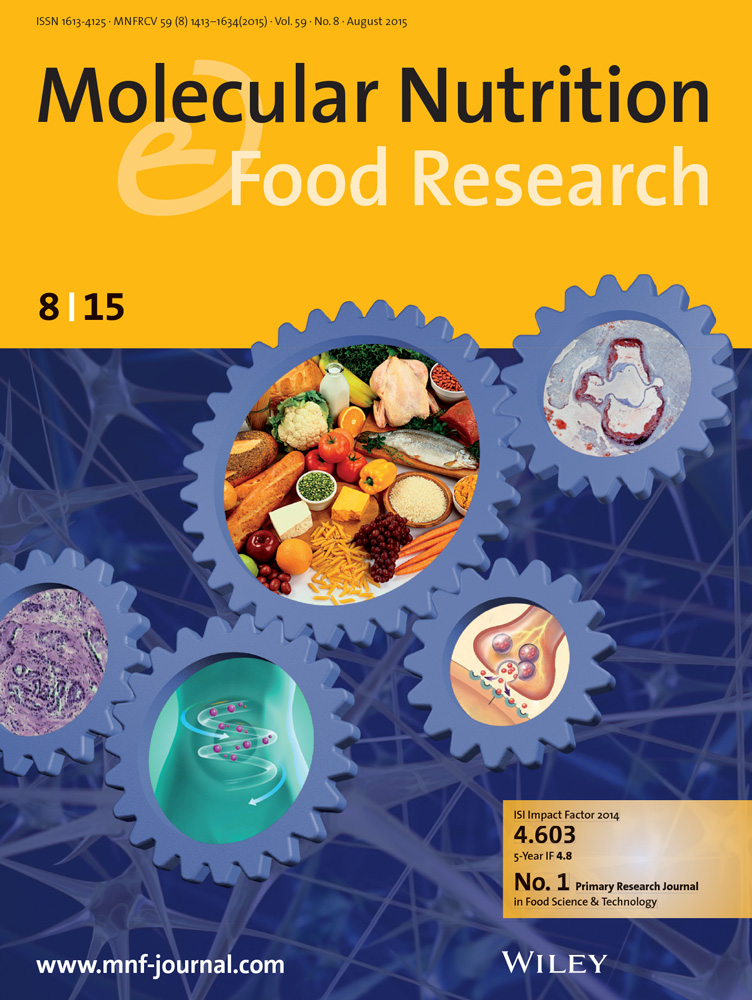Tomato Puree Enrichment in a High-Fat Meal Reduces Postprandial Plasma and Adipose Tissue Inflammation Biomarkers in Healthy Male Adults: A Crossover Randomized Controlled Trial.
IF 4.5
2区 农林科学
Q1 FOOD SCIENCE & TECHNOLOGY
引用次数: 0
Abstract
The postprandial period is marked by increased plasma inflammatory biomarkers and heightened adipose tissue inflammation. Consumption of tomato-based products has been linked to reduced inflammation, potentially lowering the risk of cardiometabolic diseases. This study investigated the addition of tomato puree to a high-fat meal (HFM) on postprandial inflammation in healthy men. Thirty-nine healthy men participated in a randomized crossover trial (NCT02100774). Two meals were given: a HFM and the same HFM with 100 g tomato puree (TPM). Blood samples and adipose tissue biopsies were taken at various timepoints to measure inflammatory markers. TPM reduced plasma tumor necrosis factor alpha (TNF-α), interleukin (IL)-6, and C-C motif chemokine ligand (CCL)-2, and gene expression of TNFA, IL6, IL1B, and CCL5 in adipose tissue. In contrast, HFM increased IL-1β, CCL2, and adipose gene expressions of IL6, IL1B, and CCL2. Variations and net incremental area under the curve (iAUCsnet) between groups showed significantly lower inflammatory markers in TPM, except for plasma CCL2 and CCL5 expression. Incorporating tomato puree in HFM reduces both systemic and adipose tissue inflammation during the postprandial period. These findings suggest that tomato-based products may contribute to the reduction of postprandial inflammation, potentially explaining their cardiometabolic benefits.一项交叉随机对照试验:在健康成年男性中,高脂肪膳食中富含番茄泥可减少餐后血浆和脂肪组织炎症生物标志物
餐后时期的特点是血浆炎症生物标志物增加,脂肪组织炎症加剧。食用番茄制品可以减少炎症,潜在地降低患心脏代谢疾病的风险。本研究调查了健康男性在高脂肪餐(HFM)中添加番茄酱对餐后炎症的影响。39名健康男性参加了一项随机交叉试验(NCT02100774)。两餐:一餐HFM和同样的HFM加100克番茄酱(TPM)。在不同的时间点采集血液样本和脂肪组织活检来测量炎症标志物。TPM降低血浆肿瘤坏死因子α (TNF-α)、白细胞介素(IL)-6和C-C基元趋化因子配体(CCL)-2,以及脂肪组织中TNFA、IL6、IL1B和CCL5的基因表达。相反,HFM增加了IL-1β、CCL2和脂肪基因IL6、IL1B和CCL2的表达。各组之间的变化和曲线下净增量面积(iAUCsnet)显示,除血浆CCL2和CCL5表达外,TPM炎症标志物显著降低。在HFM中加入番茄酱可以减少餐后期间的全身和脂肪组织炎症。这些发现表明,以番茄为基础的产品可能有助于减少餐后炎症,这可能解释了它们对心脏代谢的益处。
本文章由计算机程序翻译,如有差异,请以英文原文为准。
求助全文
约1分钟内获得全文
求助全文
来源期刊

Molecular Nutrition & Food Research
工程技术-食品科技
CiteScore
8.70
自引率
1.90%
发文量
250
审稿时长
1.7 months
期刊介绍:
Molecular Nutrition & Food Research is a primary research journal devoted to health, safety and all aspects of molecular nutrition such as nutritional biochemistry, nutrigenomics and metabolomics aiming to link the information arising from related disciplines:
Bioactivity: Nutritional and medical effects of food constituents including bioavailability and kinetics.
Immunology: Understanding the interactions of food and the immune system.
Microbiology: Food spoilage, food pathogens, chemical and physical approaches of fermented foods and novel microbial processes.
Chemistry: Isolation and analysis of bioactive food ingredients while considering environmental aspects.
 求助内容:
求助内容: 应助结果提醒方式:
应助结果提醒方式:


